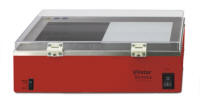 |
紫外透射仪(UVstar and WLstar Transilluminators)
|
| |
State-of-the-Art Technology for Brilliant Sample Visualisation |
 |
- Filter size from 15 cm x 15 cm up to 23 cm x 30 cm
- Exceeding uniform illumination
- High-grade filter glass for low backround
- Super Brilliant version for superior contrast available
|
| Biometra UVstar and WLstar series UV transilluminators feature a uniform and bright illumination based on modern control electronics. The exclusive application of high-grade filter glass provides for excellent documentation results with lowest backround signal. The great illumination uniformity allows the reliable quantification of electrophoretically separated fluorescent samples. |
| The UV tables offer the choice between three different UV wavelengths. The most commonly used wavelength for sample documentation is the midrange UV of 312 nm. 254 nm UV is more aggressive against samples but raises the detection sensitivity of e.g. SYBR Green I stains. 365 nm UV is preferred for preparative tasks: The detection sensitivity of the most UV fluorescent stains is lower than with 312 nm but it is less aggressive against samples. |
| There are tables with maximum number of bulbs with one wavelength (lso tables with alternating oriented bulbs of two different UV wavelengths (UVstar HM, UVstar ML). |
| The precise detection of very faint signals can be further n of a newly developed filter glas: version "Super Brilliant". This unique background uniformity filter remarkably enhances the contrast and improves the illumination uniformity even more. UVstar plus works with excitation wavelengths 312 nm and 365 nm. |
| The UVstar transilluminator is also available as dual use version: UV table and white light table: UVstar WL features a 20 cm x 20 cm filter size for UV fluorescent samples and a 20 cm x 20 cm filter size for white light transillumination in addition. |
| For pure white light transillumination the white light table WLstar can be used. |
| Alternatively to the use of a white light table a converter plate can be applied at the top of a UV transilluminator. It very easily extends the application range from documentation of UV fluorescent samples to the documentation of visible coloured samples. |
|
|